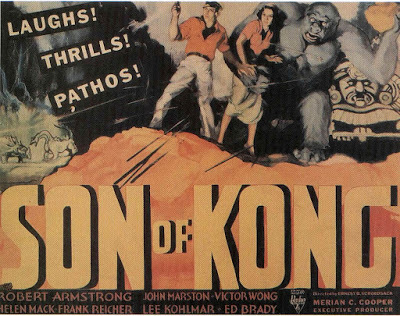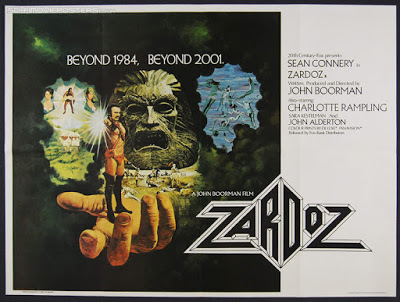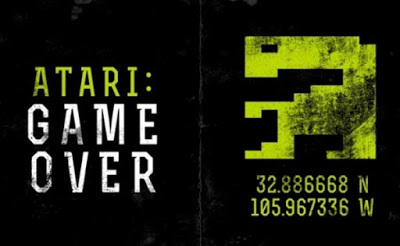Movies I Watched in May, Part 1
The second day of the month, and I've already got the first half of last month's movie recaps posted. What is this, Wackyland? Whatever it is, don't expect it in July -- but this is June, so let's get to it...

I don’t think I’ve seen this one since my first burst of monster movie love back in the 1970s. It paled next to its predecessor, “King Kong,” and wasn’t even a match for its spiritual sequel, 1949’s “Mighty Joe Young.” Even so, when it showed up on (where else?) TCM not long ago, I wanted to give it another look. It’s not much better than I remembered, with Son a weak substitute for Dad (and the poor guy dies in the end, along with every other beast on Skull Island), but the movie’s premise is pretty promising: After dragging Kong to New York and wrecking the city, Carl Denham (Robert Armstrong, still great) has to duck creditors and lawsuits until he can sneak out of the city. The most surprising thing about “Son of Kong”? It was released in 1933 – a mere eight months after its legendary father. Who says quick, cash-in sequels are a modern invention?

I’ve been hearing about this 1974 John Boorman oddity since Danny Peary covered it in “Cult Movies 2,” and before that, I probably caught a few glimpses of its distinctly seventies-style nudity late night on Cinemax. After hearing the hilarious “How Did This Get Made” podcast episode devoted to “Zardoz,” though, I couldn’t resist picking up the new Blu-ray. If you’re going to experience one of the damndest movies ever made, you might as well do it in hi-def, right? So how was it? Not good, exactly, but not bad either, and consistently fascinating. It’s one of those pre-“Star Wars” ‘70s sci-fi movies that’s really trying to say something, man, and give Boorman credit, he uses some big, bold visuals to get his message across (whatever that message is). Sean Connery’s red diaper/bandolero is the most memorable visual, unfortunately, but that giant stone head vomiting guns and ammunition all over the countryside is pretty amazing, too. I can’t recommend it to everyone, but if you’re the sort of person who likes this sort of movie, you’ll really like this movie – understand? By the way, I'll be talking about this one on the Plain Label Podcast soon -- stay tuned for more info.

Here’s the opposite of “Zardoz,” a modern sci-fi film with a tiny cast, restrained tone and distinct lack of red diapers or vomiting stone heads. Caleb (Domhnall Gleason) “wins” a week-long stay at his mysterious boss’ even more mysterious home, and when he gets there, he learns he’s supposed to get to know his boss’ latest AI project and see if she can pass for human. (Mentally, that is – her exposed mechanics make it obvious that she’s been built in a lab.) Naturally, as the week goes on and the walls of that mysterious home start to close in, the relationships between Caleb, Ava (Alicia Vikander) and the increasingly creepy Nathan (Oscar Isaac) spin off in surprising directions. Essentially a four-person movie (Nathan also has a maid, Kyoko (Sonoya Mizuno) who speaks no English), it manages to be both smart and suspenseful while still managing to deliver enough lurid thrills to keep things interesting. The cast is excellent, and the setting, while beautiful, gets more and more threatening as the movie nears its ending. Credit writer/director Alex Garland (who also wrote “Dredd,” “Sunshine” and “28 Days Later”) for delivering one of the best movies of the year – and one with an ending that will leave you pondering its implications long after the credits roll.

Short, slight (but amusing) little documentary about the urban legend that Atari buried thousands of unsold copies of its legendarily awful “E.T.” game under the sands of Alamogordo, New Mexico. Before getting to the excavation at the ending (which I won’t spoil here), director Zak Penn delivers a quick history of Atari, which frankly, is the most interesting thing in the movie. He touches base with plenty of game designers, who describe the anything-goes, pot-clouded atmosphere that fueled all that creativity until the bottom inevitably dropped out. Just seeing games like “Adventure” and “Pitfall” was a kick for this old 2600 owner (it’s still in the basement!), but the way the movie pitched Howard Scott Warshaw (who designed “E.T” and other, more successful games) as a martyr to history who will find redemption if they dig up a bunch of old cartridges was, well, more than a bit of a reach. For me, the big irony was seeing a cameo from George R.R. Martin, writer of “Game of Thrones.” That’s because there’s a great 2003 novel that no one’s read called “Lucky Wander Boy,” and one of the subplots involves those buried “E.T.” games. The writer behind it? D.B. Weiss, now one of the main minds guiding “Game of Thrones” on HBO. Hope he writes another book one of these days.

I don’t think I’ve seen this one since my first burst of monster movie love back in the 1970s. It paled next to its predecessor, “King Kong,” and wasn’t even a match for its spiritual sequel, 1949’s “Mighty Joe Young.” Even so, when it showed up on (where else?) TCM not long ago, I wanted to give it another look. It’s not much better than I remembered, with Son a weak substitute for Dad (and the poor guy dies in the end, along with every other beast on Skull Island), but the movie’s premise is pretty promising: After dragging Kong to New York and wrecking the city, Carl Denham (Robert Armstrong, still great) has to duck creditors and lawsuits until he can sneak out of the city. The most surprising thing about “Son of Kong”? It was released in 1933 – a mere eight months after its legendary father. Who says quick, cash-in sequels are a modern invention?

I’ve been hearing about this 1974 John Boorman oddity since Danny Peary covered it in “Cult Movies 2,” and before that, I probably caught a few glimpses of its distinctly seventies-style nudity late night on Cinemax. After hearing the hilarious “How Did This Get Made” podcast episode devoted to “Zardoz,” though, I couldn’t resist picking up the new Blu-ray. If you’re going to experience one of the damndest movies ever made, you might as well do it in hi-def, right? So how was it? Not good, exactly, but not bad either, and consistently fascinating. It’s one of those pre-“Star Wars” ‘70s sci-fi movies that’s really trying to say something, man, and give Boorman credit, he uses some big, bold visuals to get his message across (whatever that message is). Sean Connery’s red diaper/bandolero is the most memorable visual, unfortunately, but that giant stone head vomiting guns and ammunition all over the countryside is pretty amazing, too. I can’t recommend it to everyone, but if you’re the sort of person who likes this sort of movie, you’ll really like this movie – understand? By the way, I'll be talking about this one on the Plain Label Podcast soon -- stay tuned for more info.

Here’s the opposite of “Zardoz,” a modern sci-fi film with a tiny cast, restrained tone and distinct lack of red diapers or vomiting stone heads. Caleb (Domhnall Gleason) “wins” a week-long stay at his mysterious boss’ even more mysterious home, and when he gets there, he learns he’s supposed to get to know his boss’ latest AI project and see if she can pass for human. (Mentally, that is – her exposed mechanics make it obvious that she’s been built in a lab.) Naturally, as the week goes on and the walls of that mysterious home start to close in, the relationships between Caleb, Ava (Alicia Vikander) and the increasingly creepy Nathan (Oscar Isaac) spin off in surprising directions. Essentially a four-person movie (Nathan also has a maid, Kyoko (Sonoya Mizuno) who speaks no English), it manages to be both smart and suspenseful while still managing to deliver enough lurid thrills to keep things interesting. The cast is excellent, and the setting, while beautiful, gets more and more threatening as the movie nears its ending. Credit writer/director Alex Garland (who also wrote “Dredd,” “Sunshine” and “28 Days Later”) for delivering one of the best movies of the year – and one with an ending that will leave you pondering its implications long after the credits roll.

Short, slight (but amusing) little documentary about the urban legend that Atari buried thousands of unsold copies of its legendarily awful “E.T.” game under the sands of Alamogordo, New Mexico. Before getting to the excavation at the ending (which I won’t spoil here), director Zak Penn delivers a quick history of Atari, which frankly, is the most interesting thing in the movie. He touches base with plenty of game designers, who describe the anything-goes, pot-clouded atmosphere that fueled all that creativity until the bottom inevitably dropped out. Just seeing games like “Adventure” and “Pitfall” was a kick for this old 2600 owner (it’s still in the basement!), but the way the movie pitched Howard Scott Warshaw (who designed “E.T” and other, more successful games) as a martyr to history who will find redemption if they dig up a bunch of old cartridges was, well, more than a bit of a reach. For me, the big irony was seeing a cameo from George R.R. Martin, writer of “Game of Thrones.” That’s because there’s a great 2003 novel that no one’s read called “Lucky Wander Boy,” and one of the subplots involves those buried “E.T.” games. The writer behind it? D.B. Weiss, now one of the main minds guiding “Game of Thrones” on HBO. Hope he writes another book one of these days.
Published on June 02, 2015 16:09
No comments have been added yet.
Will Pfeifer's Blog
- Will Pfeifer's profile
- 23 followers
Will Pfeifer isn't a Goodreads Author
(yet),
but they
do have a blog,
so here are some recent posts imported from
their feed.



